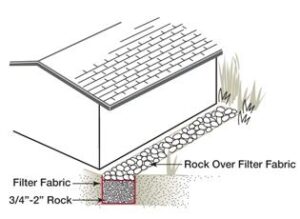An infiltration pit or trench can reduce the amount of runoff from your property by storing water underground and allowing it to soak into the soil. The size and holding capacity are determined by the area draining to the pit and the permeability of the underlying soil.
Rock is one material often used to fill pits and trenches. Once the pit or trench is dug, but before the rock fill is added, a filter fabric liner is put down. This prevents the soil from washing out from under the rocks or entering the pore space between the rocks. Without this barrier, soil can reduce water-holding capacity.

The pit is dug…

…lined with filter fabric…

…and filled with rock.
During a rain event, water is diverted to the pit or trench where it fills the spaces between the rocks and soaks into the soil.
Rock infiltration trenches work well along parking areas or rooflines without gutters. They absorb the impact of falling water to prevent erosion, and then store the water until it soaks into the soil.

In place of rock, infiltration pits can also be constructed with a matrix of hollow plastic blocks that are wrapped in filter fabric and then buried to create underground water storage. Aquablox is one brand available. They are particularly advantageous in small or odd-shaped areas that are not conducive to other, more sizeable infiltration practices. They have a much higher per area storage capacity than the rock.

To see example projects from Balsam Lake, click on this link.
